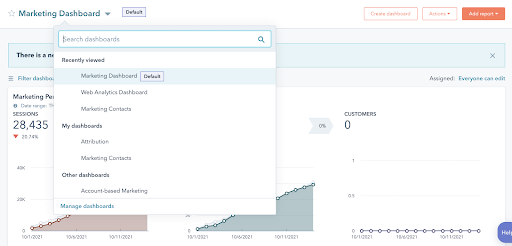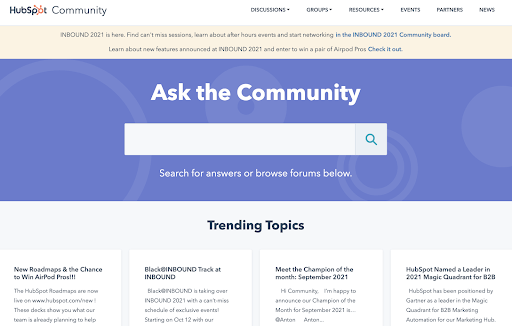


If you’ve made the decision to leverage the HubSpot customer relationship management (CRM) platform, you’re in good company. HubSpot has more than 177,000 global customers who use the platform to help attract prospects, close deals, improve customer retention, and grow their businesses.
Like many others, you likely recognize the benefits of the all-in-one marketing, sales, and service platform and how HubSpot CRM implementation can help your business grow better. The full suite of software has the inbound methodology at its core, and has grown to include different Hubs that do more than just help the marketing team; they serve the entire organization.
It’s reassuring to know that HubSpot’s platform isn’t cobbled together with different code or open-source software, which have notorious quirks and security issues. Simply put, it was built intentionally as a single system and all its functionalities “play well” together.
If you’re not ready to jump into using the full suite of HubSpot tools yet and are just getting started with the free CRM system, that’s great! Just know that the possibilities of the full HubSpot CRM solution are endless and, as your business grows, HubSpot can grow with you.
Meanwhile, let’s cover the very basics to help you get started with HubSpot CRM implementation.
HubSpot implementation involves effective change management and communication. For the entire organization to receive the intended benefits, marketing, sales, service, and operational teams need to be willing to use the system.
Here are seven tips to ensure your HubSpot CRM implementation process goes smoothly.
Before you dive right in, it’s important to understand HubSpot’s common CRM components and how to organize your data using the following categories.
Once you have an understanding of how your information will be stored in the CRM, you’re ready to begin the basic HubSpot setup, including things like:
HubSpot has great resources in its knowledge base to guide you through these basic setup items, including this free HubSpot Academy course that will help you get started.
Pro tip: You can also work with a HubSpot partner agency (like Weidert Group) to get help with onboarding and setup. Learn more about your customizable onboarding options here.
One of the keys to successful CRM adoption is to complete a Sales process map to help identify the deal stages and lead statuses that support your main funnel. You also need to understand the automation needs for lead routing and notifications. This is where it can start to get a bit more complicated for a CRM implementation team.
RELATED: Benefits of CRM vs. Manual Lead Qualification
A foundational step is to ensure that your Sales and Marketing departments are aligned and working toward the same goals, and that each has a common understanding of the HubSpot tools and technology. In particular,
One of the best ways to engage your sales reps and get them excited about the ways that HubSpot CRM can improve the quantity and quality of leads is to develop a Marketing & Sales service level agreement (SLA).
RELATED: Why Find a HubSpot Partner to Help With Objectives-Based Onboarding
In addition to your marketing and sales teams, it’s important to engage your customer service team. They’ll appreciate the tracking capabilities that HubSpot offers, plus the ability to issue tickets, enter call notes, set up tasks and notifications for follow-up, and a host of other customer-centric features.
Consider which other teams need to use the CRM and how they can contribute to your success.
The entire organization really needs to buy into the platform to ensure there aren’t multiple disparate systems floating around. The CRM should be the heart of a scaling business and having a single source of truth in one platform facilitates that.
You’ll want to set up your marketing, sales, and service dashboards which come with default report settings. These dashboards allow users to see the information that’s most relevant to them. Reports can be filtered, moved, resized, and customized in various ways to make it as functional as possible for each department and user.

To promote widespread user adoption, help teams learn to set up tools that THEY can use right away. Right out of the gate, sales teams and marketers can:
In addition to the CRM, HubSpot Sales Hub Pro has even more features that facilitate remarkable experiences for both your internal sales teams and customers/prospects. Email templates, snippets for quick replies, automated sequences for lead follow-up, document libraries, 1:1 web video, and more are part of the paid Sales Hub features that help teams be more efficient and effectively close more deals — but only if they’re actually used!
Just as important as training colleagues how to use the CRM and Sales Hub tools is training them about the expectations for using it. Never forget the “what’s in it for them?” It may be wise to start with one salesperson to serve as the pioneer and advocate before rolling it out to the entire team.
RELATED: 7 Awesome Features of HubSpot Sales & CRM Software That'll Help You Close More Deals
There’s a vast online HubSpot Community that is eager to share their experiences, answer questions, and help troubleshoot when you might hit a snag. You can view examples from other users and even submit feedback to the HubSpot product team.
Take advantage of HubSpot Academy to learn not only about the tool but inbound practices as well. In fact, there’s an online lesson on how to participate in the HubSpot Community that will show you how to get started and interact with other professionals. You can even sign up for the Community newsletter to stay in the know. Additionally, you can earn numerous certifications after completing online courses, and gain a much deeper understanding of how to leverage the HubSpot platform.

Even though HubSpot has an exhaustive knowledge base with countless tutorials, it can feel a bit overwhelming. With a lot of functionality comes a lot of information to digest. It doesn’t hurt to explore partnering with a HubSpot expert who specializes in helping companies with successful implementation and onboarding.
Full disclosure: Weidert Group is a HubSpot Diamond partner and we offer such a service. We’re happy to talk through what's involved and how much quick-start or guided onboarding for your HubSpot CRM costs. In general, the onboarding process takes you through how to properly set up and manage the tools, which saves you a lot of time and helps you implement HubSpot’s functionality more quickly. It’s important to place a value on your time and the underlying costs of delaying your implementation.
We also provide strategic guidance that’s tailored to your business, and help with CRM adoption among teams — a major hurdle that can stop progress in its tracks. Once you’ve launched your HubSpot CRM and are up and running, someone will be there to provide additional support, answer questions, or help with additional templates, sequences, documents, and automation, for example.
Check out our customizable onboarding options to explore how we can help you hit the ground running with your HubSpot implementation. Just click to learn more about our quick-start and guided onboarding options that are customizable to fit your goals.
Topics: Marketing Technology, Inbound Marketing, Inbound Sales, HubSpot
